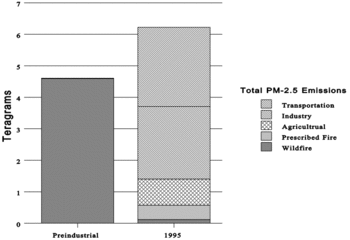 |
| English: Preindustrial and contemporary PM2.5 emissions. (Photo credit: Wikipedia) |
Key Quotes:
“People can be exposed to particulate matter in indoor or outdoor environments…particulate levels can vary from 5000 to 10,000 particles/cm3 in outdoor air. This number can increase to 300,000 particles/cm3 or even 1,000,000 particles/cm3 on streets with high traffic volumes.”
“measurements of particles can vary widely, even those made for the same material and in the same place. This variation is mainly caused by the equipment used for measuring particles and the sampling procedures.”
“Primary particles are directly emitted into the atmosphere. Primary particles are composed of fine particles, with diameter less than 2.5 μm (PM2.5), and by ultrafine particles, with diameters smaller than 0.1 μm”
“Particles generated by mechanical or chemical reactions in the atmosphere are classified as secondary particles. Secondary particles are coarse. They have diameters greater than 2.5 μm. Coarse particles include particulate matter smaller than 10 μm in diameter (PM10) and total Suspended Particle Matter (TSP)”
“The Spotmeter, which is used to measure concentration of BC through absorption of light, has been reported as being capable of measuring all the particle size ranges. Detection limit of this piece of equipment is 25 μg/m3.”
“The device with highest accuracy …was the Scattering Photometer (30%). On the other hand, the measurement methods based on filters were the least accurate (5%).”
“Measurements related to UFP[ultra fine particles] are important, particularly in health-related studies. In this case, the most recommended equipment is measures the numerical concentration of particles, as in the case of SMPS[Scanning Mobility Particle Sizer] , FMPS[Fast Mobility Particle Sizer], ELPI[Electrical Low Pressure Impactor], and OPC[Optical Particle Counter].”
“17 institutes were interviewed about the equipment that they used to measure particulate matter. SMPS and ELPI were used by 50% of all institutes… and the ELPI works in real time”








No comments:
Post a Comment